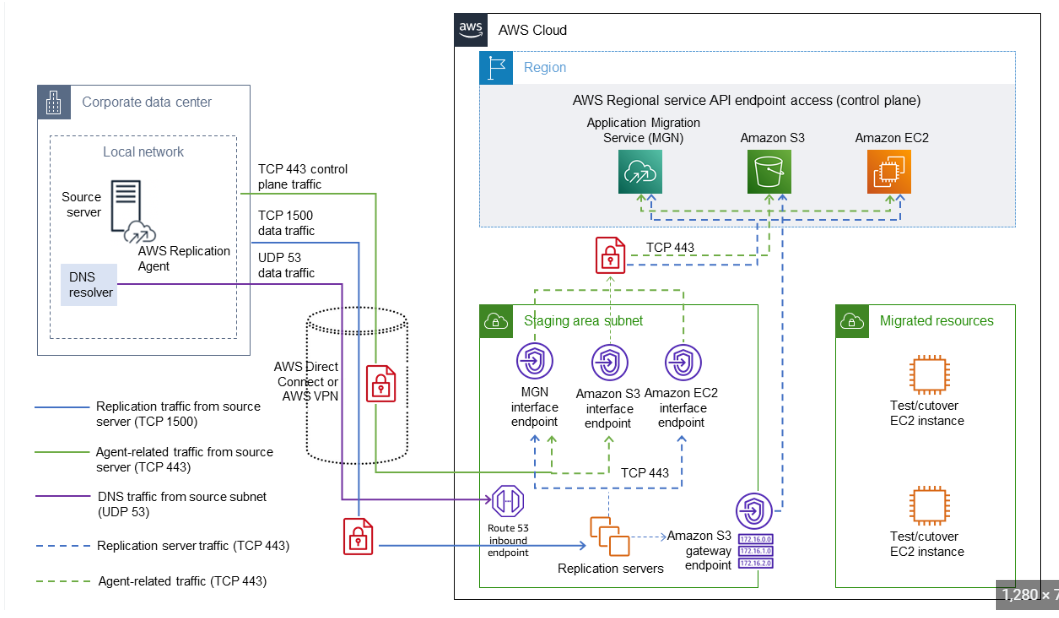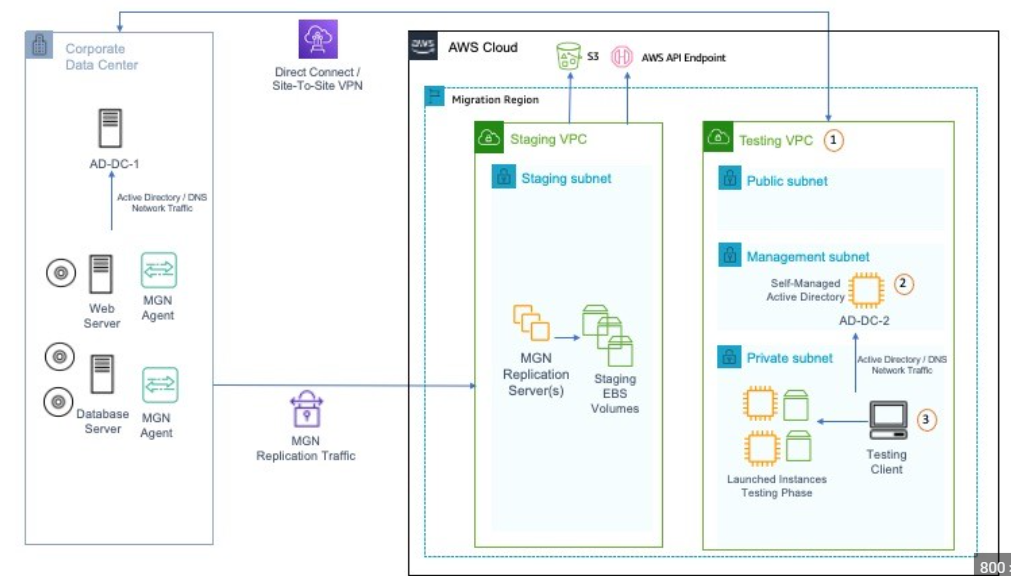Migrating to AWS Cloud with AWS MGM
AWS Migration Hub (previously known as AWS MGM) offers a centralized location to track, manage, and execute migrations from on-premise, other cloud platforms, or other parts of AWS. Using AWS Migration Hub provides visibility and control over the migration process, allowing you to manage all your migrations from a single interface. Here’s a detailed look at the migration strategy using AWS Migration Hub, along with best practices and a business use case.

Migration Strategy Using AWS Migration Hub
1. Assess:
- Discovery: Begin by using tools like AWS Application Discovery Service to gather information about your on-premises data centers, including servers, VMs, applications, and usage data. This helps in planning by identifying dependencies and workload sizing.
- Planning: Based on the collected data, categorize applications and data based on criticality, complexity, and cloud readiness. Decide on the migration strategy for each (e.g., rehost, refactor, rebuild, or replace).
2. Mobilize:
- Prepare your environment for migration. This involves setting up the necessary AWS resources, creating a landing zone, and defining roles and permissions using AWS IAM.
- Optimize your migration strategy by resolving potential issues identified during the assessment phase, such as dependencies and compatibility issues.
3. Migrate:
- Execute Migration: Use AWS Migration Hub to choose the right tools for each migration task, whether it’s database migration with AWS DMS or server migration with AWS SMS.
- Track Progress: Monitor the status of each migration task through the Migration Hub dashboard, adjusting resources and strategies as needed.

Best Practices
- Centralized Tracking: Use AWS Migration Hub to keep track of all your migrations. It provides detailed dashboards and progress updates for each application.
- Iterative Approach: Start with less complex applications to gain confidence and refine your migration process before moving on to more critical systems.
- Automate as Much as Possible: Utilize automation tools within AWS to streamline migrations, reduce errors, and speed up the process. AWS SMS and DMS can automate the migration of virtual servers and databases, respectively.
- Ensure Compliance and Security: Integrate AWS security tools (like AWS Shield, AWS WAF) from the start of your migration process. Ensure that all data is encrypted in transit and at rest.
- Post-Migration Testing and Optimization: After migration, thoroughly test for functionality, performance, and security. Use AWS’s optimization tools such as AWS Trusted Advisor to analyze and optimize your new cloud environment.
Business Use Case: E-Commerce Platform Migration
Situation: An e-commerce company operating on an on-premises data center experiences fluctuating traffic, leading to frequent over-provisioning of resources.
Goal: Migrate to AWS to achieve scalable, flexible infrastructure that supports varying traffic levels efficiently.
How to migitrate from Onpremise to AWS Cloud using AWS MGM Service
Migrating from an on-premise environment to the AWS cloud using AWS Migration Hub (previously referred to as AWS MGM service) involves a structured approach that leverages AWS services and tools to streamline the process. Here’s a step-by-step guide to help you understand how to use AWS Migration Hub for a smooth migration:
Step 1: Plan Your Migration
Assessment:
- Discover: Use the AWS Application Discovery Service to collect information about your on-premise resources. This includes server utilization data, application dependencies, and performance metrics.
- Evaluate: Assess your on-premise applications and data to determine their readiness for migration. Tools like the AWS Migration Evaluator (formerly TSO Logic) can help analyze and project cost savings and the optimal migration method.
Migration Strategy:
- Decide on a migration strategy appropriate for each application based on the 5 Rs: Rehost, Refactor, Revise, Rebuild, or Replace.
- Consider the business impact, technical complexity, and resource availability.
Step 2: Mobilize
Prepare the AWS Environment:
- Set up your AWS environment, which includes configuring your Virtual Private Cloud (VPC), subnets, IAM roles, security groups, and any necessary endpoint services.
- Establish a Migration Landing Zone—a well-architected, multi-account AWS environment that can support the scale of your migration.
Address Pre-Migration Concerns:
- Resolve any compatibility issues, such as differences in operating systems or database engines.
- Plan for any necessary changes or refactorings that must occur before or during migration.
Step 3: Migrate
Select Tools and Begin Migration:
- AWS Server Migration Service (SMS): Use this for migrating VMs from VMware, Hyper-V, or Microsoft Azure.
- AWS Database Migration Service (DMS): Migrate your databases to AWS, supporting homogeneous and heterogeneous migrations.
- Leverage AWS Migration Hub to track the progress of each migration task. It provides a central place where you can monitor and manage migrations from multiple AWS and partner migration tools.
Execute:
- Implement the migrations in phases, starting with less critical applications to mitigate risks.
- Use the AWS Migration Hub’s dashboard to monitor the progress and address any issues in real-time.
Step 4: Validate and Optimize
Testing:
- Once the migration is executed, perform comprehensive testing to ensure everything is running as expected. This should include performance testing to verify that the application meets its required service levels.
Optimization:
- Utilize AWS’s native tools like AWS Cost Explorer to manage and optimize costs.
- Continuously monitor application performance and security post-migration using AWS CloudWatch and AWS Trusted Advisor.
Iterate:
- Based on feedback and performance metrics, make necessary adjustments to resources and configurations.
- Continue to migrate additional applications based on the insights and lessons learned from earlier phases.
Step 5: Operate and Scale
- Shift to an operational mindset, focusing on managing and scaling the newly migrated applications.
- Use AWS services to enhance performance, security, and reliability based on ongoing assessment and business needs.
By following these steps and using AWS Migration Hub effectively, organizations can simplify the migration process, reduce risks, and accelerate their transition to the cloud. This structured approach ensures that each phase of the migration is planned, executed, monitored, and optimized for success.
Approach:
- Assessment: Identify all components of the e-commerce platform using AWS Application Discovery Service. Evaluate dependencies, especially for the transaction processing system.
- Planning and Mobilize: Opt for a phased migration strategy. Start with non-critical systems such as the blog and static content, followed by inventory management, and finally the transaction processing system.
- Migrate:
- Use AWS SMS for the migration of virtual machines running the web front-end.
- Employ AWS DMS for database migration, ensuring minimal downtime for the transaction database.
- Monitor and adjust the migration using AWS Migration Hub.
Outcome: Successful migration with enhanced scalability and reduced operational costs. The ability to scale resources dynamically led to improved handling of peak traffic periods, such as Black Friday sales, without over-provisioning.
This strategy and use case highlight how AWS Migration Hub facilitates a structured and effective migration process, allowing businesses to transition smoothly to the AWS cloud while minimizing disruptions and optimizing costs.
#AWSMigrationHub #AWSMGM #CloudMigration #AWSMigration #MigrateToAWS #AWSMigrationServices #AWSCloud #DataMigration #AWSBestPractices #TechTransformation
